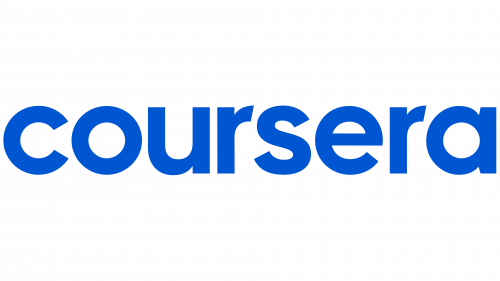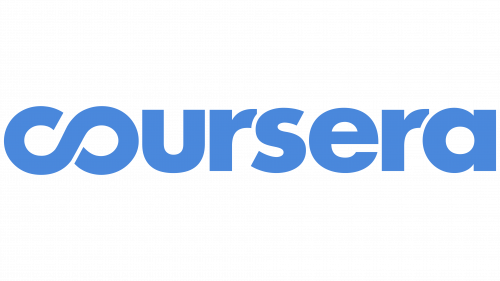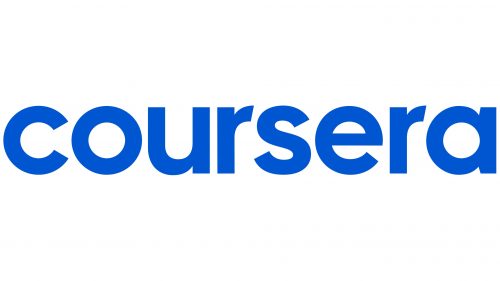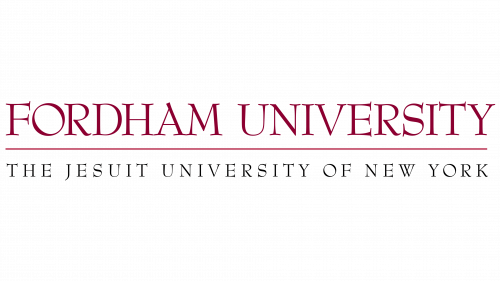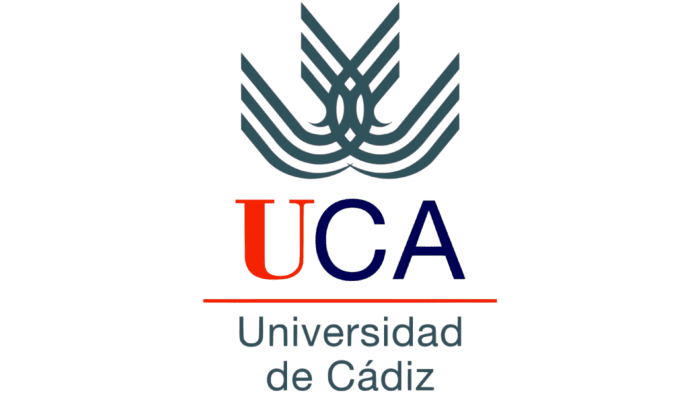The Coursera logo stands out for its individuality and elegant simplicity. It embodies restraint and conciseness while maintaining unique elements that give it character. The modern version of the logo differs significantly from previous ones, reflecting minimalism in every aspect. This is also emphasized by the color palette, which leans toward natural tones. On a white background, like clouds floating in the sky, soft blue letters attract the eye and hold attention while creating a sense of aesthetic pleasure.
The logo is visually appealing and conveys the essence of the most popular educational platform. The font, with neat serifs and smooth curves, turns the letters into distinct geometric symbols, each differing in shape. The bold typeface gives the inscription massiveness and solidity, creating an impression of stability and reliability. This allows one to assert that the logo successfully communicates Coursera’s dependability as an educational platform and the high level of knowledge it offers.
Coursera: Brand overview
Coursera began in 2011 when Andrew Ng and Daphne Koller, two Stanford computer science professors, started exploring the potential of online learning. They aimed to make higher education accessible to people worldwide through the Internet.
Ng’s first online machine learning course, released in October 2011, attracted over 100,000 students globally. This unexpected success inspired the creation of Coursera and highlighted the vast potential of online education.
The platform was officially founded in April 2012, with $16 million in startup funding from venture capital firms Kleiner Perkins Caufield & Byers and New Enterprise Associates. From the outset, the company positioned itself as a platform offering courses from top universities worldwide.
At launch, Coursera partnered with Stanford, Princeton, the University of Michigan, and the University of Pennsylvania. These collaborations ensured high-quality educational content, crucial to the platform’s rapid growth.
In its first year, the platform gained momentum quickly. By the end of 2012, it had over 2 million registered users and partnerships with 33 universities. The company also secured an additional $22 million in funding that year.
2013 was a year of major growth and innovation for the company. It launched its first Specialization program—a series of related courses ending with a capstone project to give students a more structured learning experience.
That same year, the platform began working with businesses and organizations to create career-focused courses, expanding its appeal beyond students to professionals looking to advance their careers.
In 2014, the company made education even more accessible by launching its mobile app. That year also saw the introduction of the first fully online master’s program in partnership with the University of Illinois.
A key development in the business model came in 2015 with the launch of Coursera for Business. This corporate learning solution allows companies to use the platform’s courses for employee development.
In 2016, the platform expanded its degree offerings by introducing a master’s in accounting with the University of Illinois, reinforcing its position as a service capable of offering full educational programs and individual courses.
The company’s global reach grew in 2017 as it expanded partnerships with institutions worldwide and offered more courses in multiple languages.
2018, the platform partnered with the University of London to launch its first undergraduate degree program. This was a significant milestone, enabling students to complete their higher education online.
In 2019, the company introduced Coursera Plus, a subscription service providing unlimited access to most courses and Specializations. This offering was designed for those interested in lifelong learning.
Despite global challenges in 2020, the platform continued to grow. It launched Coursera for Campus, allowing universities to integrate its online courses into their curricula.
In 2021, the company saw further growth with its successful IPO on the New York Stock Exchange, solidifying its leadership position in online education and providing additional resources for expansion.
In 2022, the platform expanded its services with new partnerships and programs, focusing on developing skills employers seek, such as digital marketing, data analytics, and artificial intelligence.
By 2023, the platform had become one of the world’s leading online learning services. The company remains dedicated to democratizing access to high-quality education globally while continuing to push the boundaries of educational technology and expanding partnerships with businesses and academic institutions.
What started as a project by two professors has evolved into a global education platform, transforming how people learn in today’s world. The company continues to innovate, remaining true to its mission of expanding access to education while adapting to the changing needs of students and the workforce.
Meaning and History
What is Coursera?
This massive online learning platform has revolutionized education by making top-tier university courses accessible to a broad audience. From computer science to philosophy, the platform offers a wide range of courses, specializations, and full degree programs designed by leading universities worldwide. Its intuitive interface allows users to easily engage with interactive quizzes, peer-reviewed assignments, and video lectures at their own pace, removing traditional barriers to higher education. The platform helps democratize learning by providing access to informal skill-building courses and professional certificates, promoting continuous development and career growth.
2012 – 2020
Coursera’s educational platform first introduced its original logo in 2012, simultaneously launching online courses on its website. At that time, the logo looked attractive and had a complete design with several unique features.
The brightness of perception was achieved through an original color palette. On a white background, uniform letters in a soft blue shade stood out, creating a light and modern image. All the letters were large, capitalized, and necessarily bold, giving the logo a sense of solidity.
The identity was particularly memorable due to an original symbol that stood out. The first two letters — “C” and “O” — were merged into a single element, evoking an association with the infinity symbol. This successfully emphasized the platform’s concept of offering various courses, programs, and tests for learning. The platform’s name was arranged in a single line, and the spacing between the letters, except for the first two, remained even, adding clarity and balance to the logo.
2020 – today
The new version of the Coursera logo embodies simplicity and modernity. Unlike previous designs, the infinity symbol was removed, and now each emblem letter appears close to each other, creating a sense of unity and harmony. This approach symbolizes the unity of knowledge and learning the platform strives to offer its users worldwide.
The main focus became a rich blue color. This shade symbolizes trust, professionalism, and stability, perfectly fitting a quality education platform. The blue color refreshes and adds dynamism, emphasizing growth and the pursuit of excellence.
The font in the logo is sans-serif, with soft, rounded, and even lines, making it easy to read and visually appealing. The rounded forms of the letters create a sense of openness and accessibility—values crucial for the educational platform. The font also highlights the modern approach to learning that Coursera offers: no complexities, only accessibility and simplicity.
The emblem’s style is minimalist but not without depth. Every detail, from the font to the color, works towards the overarching idea: learning is available to everyone, and knowledge unites us. This branding emphasizes the company’s main mission—to provide quality education to people worldwide, regardless of their location.
At the time of the identity change, the platform was already one of the leading educational services in the world, and its new visual mark reflects this status. The platform was actively evolving, adding new courses and programs, and the minimalist logo reflected this evolution: everything unnecessary was removed, leaving the essential—access to knowledge and learning that changes lives.
